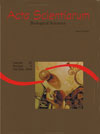<b><em>Varroa destructor</em> mite mortality rate according to the amount of worker broods in africanized honey bee (<em>Apis mellifera L.</em>) colonies</b> - DOI: 10.4025/actascibiolsci.v29i3.487
Abstract
The Varroa destructor mite has caused the death of hundreds of thousands of Apis mellifera colonies in several countries worldwide. However, the effects determined by the Varroa mite change according to the A. mellifera subspecies. In Africanized bee colonies from South and Central America, the parasite causes little damage, as the infestation levels are relatively stable and low, thus treatments against the pest are not required. Among several factors, the grooming behavior of Africanized worker bees plays an important role in the maintenance of the low infestation levels. This study determined the daily rate of live and dead mites found at the bottom of the hive in five Africanized honey bee colonies. During fifteen days of observations, a significant increase was verified in the number of live and dead mites at the bottom of the hive as the amount of worker broods from each honey bee colony decreased. This suggests a more intense grooming activity as the Varroa concentration in the adult honey bee population increases.Downloads
Download data is not yet available.
Published
2007-12-05
How to Cite
Junkes, L., Guerra Junior, J. C. V., & Moretto, G. (2007). <b><em>Varroa destructor</em> mite mortality rate according to the amount of worker broods in africanized honey bee (<em>Apis mellifera L.</em>) colonies</b> - DOI: 10.4025/actascibiolsci.v29i3.487. Acta Scientiarum. Biological Sciences, 29(3), 305-308. https://doi.org/10.4025/actascibiolsci.v29i3.487
Issue
Section
Ecology and Limnology
DECLARATION OF ORIGINALITY AND COPYRIGHTS
I Declare that current article is original and has not been submitted for publication, in part or in whole, to any other national or international journal.
The copyrights belong exclusively to the authors. Published content is licensed under Creative Commons Attribution 4.0 (CC BY 4.0) guidelines, which allows sharing (copy and distribution of the material in any medium or format) and adaptation (remix, transform, and build upon the material) for any purpose, even commercially, under the terms of attribution.
Read this link for further information on how to use CC BY 4.0 properly.
0.6
2019CiteScore
31st percentile
Powered by 

0.6
2019CiteScore
31st percentile
Powered by 











1.png)




3.png)













